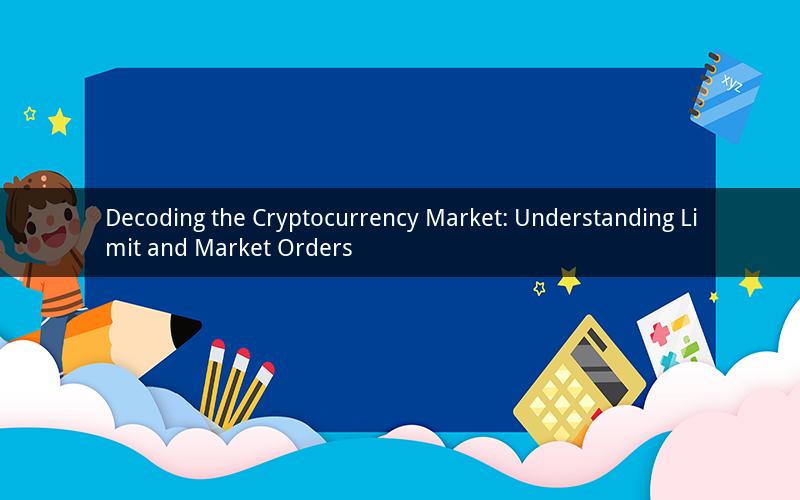
In the dynamic world of cryptocurrency trading, two terms often come up frequently – limit and market orders. These two types of orders play a crucial role in the success of a trader's strategy. But what exactly do these terms mean, and how can they impact your trading decisions? Let's delve deeper into the world of limit and market orders to help you navigate the cryptocurrency market more effectively.
What is a Limit Order?
A limit order is an order placed by a trader to buy or sell a cryptocurrency at a specific price. This means that the trade will only execute if the market price reaches the price set by the trader. Limit orders can be used to enter or exit a position at a favorable price, but they come with certain risks and limitations.
Advantages of Limit Orders
1. Price Control: Limit orders allow traders to set a specific price at which they want to buy or sell their cryptocurrency. This can be particularly beneficial when trying to enter or exit a position at a desired price.
2. Risk Management: By setting a limit price, traders can control their potential losses or gains. This can be especially useful in volatile markets, where prices can change rapidly.
3. Execution Assurance: Once the market price reaches the limit price set by the trader, the order will be executed immediately. This provides a level of assurance that the trade will be executed at the desired price.
Disadvantages of Limit Orders
1. Price Miss: If the market price moves too quickly or too far, a limit order may not be executed. This can result in missing out on the desired price.
2. Slippage: In fast-moving markets, the execution price may be slightly different from the limit price due to slippage. This can occur when there is a lack of liquidity in the market.
3. Time Limit: Limit orders are only valid until they are filled or canceled. If the market price does not reach the limit price within the time frame, the order will expire.
What is a Market Order?
A market order is an order to buy or sell a cryptocurrency at the best available price in the market. This means that the trade will be executed immediately, and the price at which the trade is executed will be the current market price.
Advantages of Market Orders
1. Immediate Execution: Market orders are executed immediately, ensuring that traders can enter or exit positions without delay.
2. No Price Uncertainty: Since market orders are executed at the current market price, there is no uncertainty about the final execution price.
3. Liquidity: Market orders can help maintain market liquidity by providing immediate buying and selling opportunities.
Disadvantages of Market Orders
1. Price Risk: Market orders can be executed at a price that is not necessarily favorable to the trader, especially in volatile markets.
2. Slippage: In fast-moving markets, there can be a significant difference between the requested price and the executed price, leading to slippage.
3. Potential for Losses: Since market orders are executed at the current market price, there is a risk of incurring losses in a rapidly declining market.
Limit vs. Market Orders: Which One is Right for You?
Choosing between a limit order and a market order depends on your trading strategy, risk tolerance, and market conditions. Here are some scenarios where each type of order may be more suitable:
1. Limit Orders: If you want to control the entry or exit price of your cryptocurrency position and are willing to wait for the market price to reach your desired level, limit orders are a good choice.
2. Market Orders: If you need to enter or exit a position quickly and are willing to accept the current market price, market orders are the way to go.
5 Questions and Answers about Limit and Market Orders
1. Q: Can a limit order be canceled after it is placed?
A: Yes, a limit order can be canceled at any time before it is executed.
2. Q: What is the difference between a limit order and a stop order?
A: A limit order is used to enter or exit a position at a specific price, while a stop order is used to protect against potential losses by setting a price at which the trade will be executed if the market price moves against the trader.
3. Q: Can a market order be executed at a price lower than the limit order?
A: No, a market order will always be executed at the current market price, which may be lower or higher than the limit order price.
4. Q: What is the maximum time for a limit order to be valid?
A: The maximum time for a limit order to be valid varies depending on the exchange, but it is typically 24 hours.
5. Q: Can a limit order be executed before the market price reaches the limit price?
A: No, a limit order will only be executed when the market price reaches the limit price set by the trader.
In conclusion, understanding the difference between limit and market orders is essential for any cryptocurrency trader. By choosing the right type of order based on your trading strategy and risk tolerance, you can navigate the cryptocurrency market more effectively and achieve your investment goals.